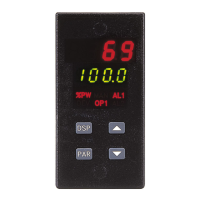Square Root Linearization (root) (Cont’d)
As a result of the scaling and square root linearization, the following
represents the readings at various inputs:
Delta P
(PSI)
Transmitter
(mA)
Flow
(Ft
3
hr
)
0.00 4.00 0
15.63 4.50 1099
31.25 5.00 1554
62.50 6.00 2198
125.00 8.00 3108
187.50 10.00 3807
250.00 12.00 4396
312.50 14.00 4914
375.00 16.00 5383
437.50 18.00 5815
500.00 20.00 6216
Decimal Point Position (dPt2)
For Remote Setpoint operation, the decimal point position is normally
programmedto bethesameas themaininput. ForInternalCascade operation,
the decimal point may be different from the main input.
Example:
If main input = 500 degrees FS,
Second Input = 15.00 PSI FS,
then dCPt = 0 and dPt2 = 0.00.
Second Analog Input Scaling Points (dSP1, INP1, dSP2, INP2)
Prior to installing and operating the indicator, it may be necessary to
change the scaling to suit the display units particular to the application.
The indicator isunique in that two different scaling methods are available.
The operator may choose the method that yields the easier or more accurate
calibration.Thetwo scalingproceduresare similarin thattheoperatorkeys in
thedisplay valuesand eitherkeysin orappliesa signalvalue thatcorresponds
tothosed isplayvaluepoints. Thelocationofthe scalingpointsshould benear
the process end limits, for the best possible accuracy.
Once these values are programmed, the indicator calculates the slope and
intercept of the signal/display graph automatically. No span/zero interaction
occurs, making scaling a one-pass exercise.
Before programming the indicator, organize all the data for the
programming steps to avoid confusion.
To scale the indicator, two signal values and two display values that
correspond to the signal values must be known. These four values are used to
complete the scaling operation. An example is listed below.
Example:
Scaling Point #1 Scaling Point #2
0.00% @ 4.00 mA AND 100.0% @ 20.00 mA
Display Values (dSP1 & dSP2)
Key-in the display value for Scaling Point 1 and Scaling Point 2.
dSP1 -999 to 9999 (Ex. 0.0%)
dSP2 -999 to 9999 (Ex. 100.0%)
Signal Input Values (INP1 & INP2)
The signal input value can either be keyed via the front panel buttons or an
input signalcan beappliedto theappropriate signal inputterminals. Initially,
the unit is in the key-in mode.
Key-in Method
Key-in the signal value for Scaling Point 1 and Scaling Point 2.
INP1 -999 to 9999 (Ex. 4.00 mA DC)
INP2 -999 to 9999 (Ex. 20.00 mA DC)
Signal Input Method
To change to the apply signal method press the DSP button. Front panel
annunciators %PW and SEC flash and the display indicates the signal value
appliedto theinputterminals.Theunitcanbe toggledtothe key-inmethodby
pressing the DSP button again.
When thedesired valueisindicated onthe display, pressthe PAR buttonto
store the value and advance to the next parameter.
The scaling of the Remote Setpoint and Internal Cascade units are
normally made equal to the physical range of the system.
Example: If the temperature control range of the process is 100 to 400
degrees, the Remote Setpoint is normally scaled to 100 and 400 degrees.
Example: The Secondary variable under internal cascade control is steam
pressure over the range of 0.00 to 60.00 PSI. The Second Analog input is
normally scaled to 0.00 and 60.00 units.

